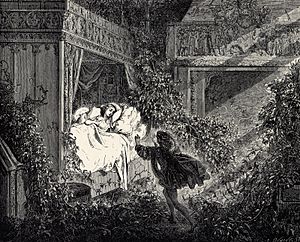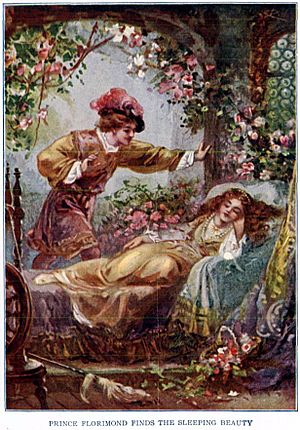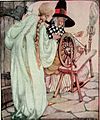Sleeping Beauty facts for kids

"Sleeping Beauty" (French: La Belle au bois dormant, or The Beauty Sleeping in the Wood); German: Dornröschen, or Little Briar Rose), also titled in English as The Sleeping Beauty in the Woods, is a fairy tale about a princess cursed by an evil fairy to sleep for a hundred years before being awakened by a handsome prince. A good fairy, knowing the princess would be frightened if alone when she wakes, uses her wand to put every living person and animal in the palace and forest asleep, to awaken when the princess does.
The earliest known version of the tale is found in the narrative Perceforest, written between 1330 and 1344. Another was the Catalan poem Frayre de Joy e Sor de Paser. Giambattista Basile wrote another, "Sun, Moon, and Talia" for his collection Pentamerone, published posthumously in 1634-36 and adapted by Charles Perrault in Histoires ou contes du temps passé in 1697.
Perrault's version first appeared in 1695 in a hand-written and illustrated manuscript called Tales of Mother Goose (French: Contes de ma mère l'oye) along with "Little Red Riding Hood", "Bluebeard", "Puss in Boots", and "Diamonds and Toads". It was next published in the newspaper Mercure galant in 1696. It was revised, and published in Paris in 1697 by Claude Barbin in Histoires ou contes du temps passé (English: Stories or Tales of Past Times), a collection of eight fairy tales by Perrault. It has been adapted to various media including a pantomime by James Robinson Planché, a ballet, and a Disney animated movie.
The Grimms published their version in Children's and Household Tales (German: Kinder- und Haus-Märchen) in 1812.
Contents
Variations
The princess's name has varied from one adaptation to the other. In Sun, Moon, and Talia, she is named Talia (Sun and Moon being her twin children). She has no name in Perrault's story but her daughter is called "Aurore". The Brothers Grimm named her "Briar Rose" in their first collection. However, some translations of the Grimms' tale give the princess the name "Rosamond". Tchaikovsky's ballet and Disney's version named her Princess Aurora; however, in the Disney version, she is also called "Briar Rose" in her childhood, when she is being raised incognito by the good fairies.
Italo Calvino included a variant in Italian Folktales, Sleeping Beauty and Her Children. In his version, the cause of the princess's sleep is a wish by her mother.
In his More English Fairy Tales, Joseph Jacobs noted that the figure of the Sleeping Beauty was in common between this tale and the Romani tale The King of England and his Three Sons.
The hostility of the king's mother to his new bride is repeated in the fairy tale The Six Swans, and also features in The Twelve Wild Ducks, where the mother is modified to be the king's stepmother.
Russian Romantic writer Vasily Zhukovsky wrote a versified work based on the theme of the princess cursed into a long sleep in his poem "Спящая царевна" ("The Sleeping Tsarevna"), published in 1832.
There are slight differences between the Grimms's version of the sleeping princess tale and that of Perrault. The Grimms's Briar Rose is released from her sleep by a kiss from the prince while Perrault's princess wakes when the prince simply kneels beside her.
Story
A king and queen long for a child. A frog in the queen's bath foretells the future birth of a baby. The queen gives birth to a daughter. The king and queen host a celebration (a christening in the Perrault version). In the Perrault version, they invite seven good fairies; in the Grimms' version, they invite twelve "wise women". Another, evil woman (or fairy) appears who puts a curse on the infant princess. She says that the princess will one day prick her finger on a spindle and die. One of the good women softens the curse. Instead of dying, the princess will sleep for one hundred years.
The king orders all spindles to be burnt to protect his daughter. When she is about fifteen or sixteen, however, the princess finds an old woman spinning in a tower room. The princess handles the spindle and pricks her finger. She falls into a deep sleep. The good fairy puts everyone in the castle to sleep. A thorny forest or a hedge of roses springs up and surrounds the castle to protect the sleeping princess.
One hundred years pass. A prince has heard fabulous tales of the place and wants to find the princess. He arrives at the castle and finds the sleeping princess in the tower room. In the Grimms' version, he wakes her with a kiss; Perrault's princess wakes when the prince simply kneels beside her. The prince and the princess get married.
The Perrault version continues further. The prince and princess have two children. The prince goes off to war. His wife and children stay with his mother. She is an ogress. She wants to eat her guests. A servant saves them. The ogress is furious. She decides to put the princess and her children into a cauldron filled with toads and snakes. The prince arrives. His wife and children are saved. The ogress jumps head first into the cauldron and dies.
- Barchilon, Jacques and Henry Pettit. 1960. The Authentic Mother Goose Fairy Tales and Nursery Rhymes. Denver: Alan Swallow. pp. 12–3.
- Betts, Christopher. 2009. The Complete Fairy Tales. Oxford UP. pp. xiv-xv, 191.
- Opie, Iona and Peter. 1974. The Classic Fairy Tales. Oxford UP. pp. 81–3.
- Tatar, Maria. 2002. The Annotated Classic Fairy Tales. Norton. pp. 95–96.
- Zipes, Jack (Ed.) 2000. The Oxford Companion to Fairy Tales. Oxford UP. pp. 467, 476.
Images for kids
-
An older image of the sleeping princess: Brünnhilde, surrounded by magical fire rather than roses (illustration by Arthur Rackham to Richard Wagner's Die Walküre)
-
Sleeping Beauty, by Henry Meynell Rheam, 1899
-
Sleeping Beauty is shown a spindle by the old woman. Sleeping Beauty, by Alexander Zick (1845–1907)
-
Sleeping Beauty and the palace dwellers under a century-long sleep enchantment (The Sleeping Beauty by Sir Edward Burne-Jones).
-
Sleeping Princess by Viktor Vasnetsov
-
Sleeping Beauty, statue in Wuppertal – Germany
See also
 In Spanish: La bella durmiente para niños
In Spanish: La bella durmiente para niños
















